Generic guidelines for the use of force against “Child Soldiers” in Peace Operations
1. To see behind
Who is a child soldier1?
The starting query which supports our essay delivers the essential: who is a child soldier? We often have seen answers based on an erroneous perspective, bringing to the problem peculiar questions, especially from the military viewpoint. Frequently, the only angle to deal with this problem is to choose between shooting to kill or shooting to scare. For the legal purpose of this paper, the accurate answer conveys a short but steady message: a child soldier is always a victim to be looked after and is never to be held accountable. Child soldering are dangerous, irrational, destructive, hopeless, disturbing, traumatizing, cruel, violent, and unleash a horrendous magnitude of the evil. Child soldering is probably one of most cruel monstrosities and together with sexual violence are standing as a token of the moral standards breakdown in modern armed conflicts. The dark hours of the night are a particular easy field to sexual and gender based violence, namely against hopeless girls and boys, committed by perpetrators and their aiders and abettors. Silence is the black veil of their shame.
To fire back without consider other options or to walk away are the easiest options, but certainly not the best ones. Personal commitment, leadership and preparedness are driving factors to succeed protecting children associated to armed groups, which is a standard duty to all peacekeepers. None of these keystones lay a hand on the fundamental right of self-defense nor prevent the use of armed force to stop the imminent attack or a direct armed attack. Nevertheless, complex problems call for comprehensive solutions. The challenges placed by children associated with armed groups, especially in the context of sexual gender based violence are to be seen through the glasses of the biding principle “best interest of the minor”.
The adoption of the use of force guidelines (ROE2) against child soldiers in peace operations must begin with learning what leads children to become soldiers. In fact, understanding what a child soldier is gives the information we need to guide our military on how to act when confronted with minors posing an imminent or direct threat to them. It has been said many times that there are children forced to join armed groups. It has also been reported that the large majority joins the armed groups without being forced to do so. Foremost, a child soldier is a product of five main combined factors: politics, economics, social/physiological, technological and tactical. Let’s shortly review each one of them:
- Politics - The general lack of public authority that characterizes failed States generates the possibility to have children enlisted in armed activities. Forced recruiting activities, despite being an international serious crime, are frequently a product of the criminal enterprises, which include individuals holding de facto power positions exercised over civilian populations, based either on an ongoing threat against people´s lives or family constraints. This type of power tends to be exercised even after the termination of the armed conflict;
- Economics - The expression “abject poverty” says almost everything. Hopeless poverty is indeed the starting point to understand that being a child soldier is not an option, but the only course in the context of manipulation, starvation, lack of access to food, absence of hope and consequently is a matter of survival. Sometimes, it represents more than the struggle of an individual to stay alive, and it is indeed a family or a community decision based on the lack of basic needs that imperils the entire community. Likewise, their labor, especially when used to collect minerals such as coltan3 or diamonds, might represent an important source of financial support for armed groups, allowing them to be self-sufficient in ammunitions and other military supplies;
- Social/physiological - Children are at the age of obeying and emulating elders. To bear a weapon is equivalent to holding a superior status of power of indiscriminate use. Carrying a gun is frequently a way of “publicity demonstrating a real “manhood” to gain status and respect”4. Uniforms, hats, weapons, drugs, alcohol, media and propaganda, the possibility of exercising power over peers, the opportunity to belong to a group, the idea of seeking protection in a male-dominated society which rewards mistreatment of women, sometimes the voodoo or other sorcery practices, constant beatings, the deliberate family killings, absurd humiliations, and finally the absence of hope, are among the many reasons why a child is forced to join armed groups;
- Technological - It might appear odd but the technology applied to the small weapons transformed them in “war toys-tools”, if we consider their light weight, their dimensions and operation procedures. New weapons are handy, small and made of steel and plastic. In short, small arms with soft recoil. Consequently, they are easily operated by small hands, tiny bodies, and well washed-out brains. Arms control failures, together with illegal trade and consequently the impunity of the dealers, provide good support to the armed activities of children. There are, indeed, small arms of large human destruction;
- Tactical (military tactics) - From the military point of view, children offer valuable features in non-international conflicts worldwide: training, logistics, intelligence, and operational engagement:
• Training - Departing from possessing nothing and having everything to lose, children are easy to train as they require minimal resources, they are fast to be taught because their lives depend on it, they require short-term training mostly using the «on the job training» formula, and violence is used as a method to produce good and fast results. Seen as instruments they are toughened by other children under senior juveniles’ supervision and the results are immediately measured in action. Mistakes are often paid with their lives.
• Logistics - Children eat less, drink less, are not paid, serve as pack animals, are able to cook, can collect wood without drawing attention, they normally have no next of kin to worry about them and consequently are replaceable and disposable. They do not need uniforms, and they are able to carry out logistic activities without leaving a military trace and because of that they are considered perfect couriers. Moreover, girl soldiers are also great fighters, the best logisticians, and serve as instruments of sexual satisfaction for regular troops.
• Intelligence - Children are children. They might be playing and collecting information. They might be moving from one place to another to visit their communities and collecting information. Forced enlisted children know how to count tracks and personnel. Children have a good visual memory and can easily identify weapons, numbers, types of vehicles, colors, locations, faces, inscriptions, and marks. Children seemed to be harmless: they move, they stay, they play, they ask, they beg… and in the end they always report to get compensation.
• Operational engagement - Children are remarkable frontline fighters. They have a particular notion of danger. They like games, they are small, move fast, shoot accurately, and are merciless. They hide easily, they pay attention to mines, and they bring new ethical issues to the foreign contingents each time they directly engage peace forces and there is a self-defense reaction.
In summary, the roots of child soldiering are many and the exploitation of those roots is an unlawful individual conduct. Becoming an enlisted child is not an option based on free will aimed at a certain result, nor is it a conscious act of engaging in conduct of a given nature. To become a child soldier is, by no means, a failure to behave like a prudent person. The criminal responsibility of an act carried out by a child soldier lies with the indirect perpetrator who acts by means of executing criminal acts through minors: the recruiter or the conscripting agent and the adult exercising effective control over the child. Enlisting and recruiting children amounts to a crime committed against children5 in situations of armed conflict6; even though the adulthood concept has not yet reached universal consensus7, international treaty law (article 7, 1)8 and customary law consider child soldiers victims, not offenders9. For the purpose of this essay we tend to assume that generally speaking a child is a human being with less than 18 years-old, acknowledging that other solutions are to be taken into consideration. They are victims who sometimes bear weapons and directly participate in the use of armed force. In this context, direct participation is understood “by covering both direct participation in combat and also active participation in military activities linked to combat such as scouting, spying, sabotage, and the use of children as decoys, couriers or placed at military checkpoints. It would not cover activities clearly unrelated to the hostilities such as food deliveries to an airbase or the use of domestic staff in an officer’s «married» accommodation. However, the use of children in direct support functions such as acting as carrying supplies to the front line, or activities at the front line itself, would be included within the terminology”10.
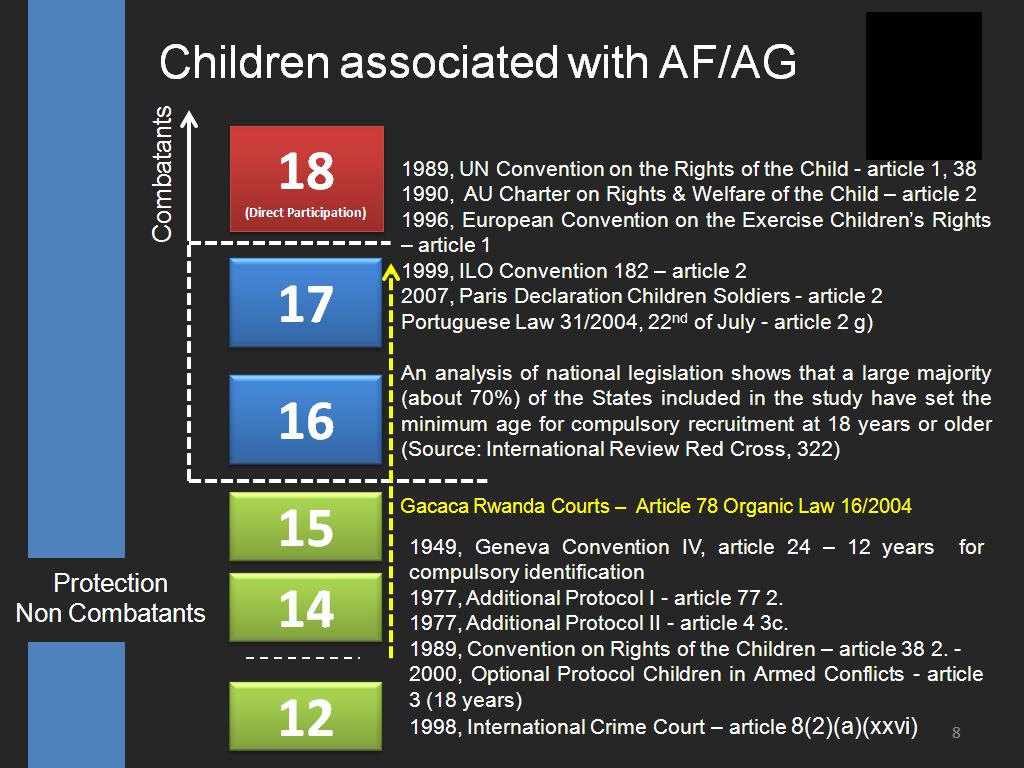
Charter 1 - Children associated with Armed Forces
Children in combat are victims who enjoy special protection (article 77 Additional Protocol I), even if engaged in the direct use of armed force (article 77 3. Additional Protocol I and article 4 3. Additional Protocol II), and consequently raise moral dilemmas every time that peace forces exercise the legitimate right of self-defense. Therefore, this essay will consider them unaccountable victims in any circumstance, adhering to the International Labor Organization Convention 182 (1999), which considers child soldiering the worst form of child labor.
2. The best prepared never works alone
We are looking for comprehensive solutions,
and not for the easy ones.
“The United Nations and regional peacekeeping forces have had to confront situations involving child victims or participants in hostilities and have, at times, demonstrated an inadequate ability to react in accordance with international standards. Tense circumstances, vague mandates, and a lack of training and operating guidelines have produced lamentable encounters between peacekeepers and youth”11. The responsibility to create the instruments to control and to hold to account peacekeeping forces lies with the United Nations Security Council12. But each field commander bears the responsibility to enforce those instruments and they also should be held accountable.
Diagram 2 - The steps
To make the linkage between the legal instruments and the field commanders’ action work, we must develop the following areas as shown on the diagram 2, bearing in mind that we are looking for comprehensive solutions, and not for the easy ones: we need to prepare the battlefield, we ought to prepare the engagement, we have to learn how to exercise targeting & self-defense, and how “help break” the recruitment chain. Let’s shortly review each of them:
Preparing the battlefield - To prepare the battlefield in peace operations we must start by understanding the individual role and the context of peacekeeping forces in terms of the balance between their operational missions and the respect of Human Rights and International humanitarian Law. This balance is particularly important, as mentioned by the Capstone Doctrine13, regarding the protection of women, children and civilians. Children remain children even if they are carrying out intelligence activities or aiming a loaded weapon at a peacekeeper. In addition, enlisted children are victims to be protected from their recruiters and are to be returned to their youth as soon as possible. In this field, peacekeepers bear special responsibilities. Likewise, it is important to learn about the situation of women and girl soldiers who seek protection in a sexual relation with a man with a gun, to avoid becoming collective sex object. These «husbands» often play the role of protector from physical hardship, food scarcity, dangerous activities, and random rapes. A girl soldier is indeed a victim among the victims, especially in traditional and conservative societies at war. Both girls and young boys “are outside or at the periphery of the system soldiers use to classify enemies (or adversaries). The confrontation with child soldiers disrupts our paradigms of professional soldiering and cultural values and beliefs we share on children”14, but is a fact of modern armed conflicts.
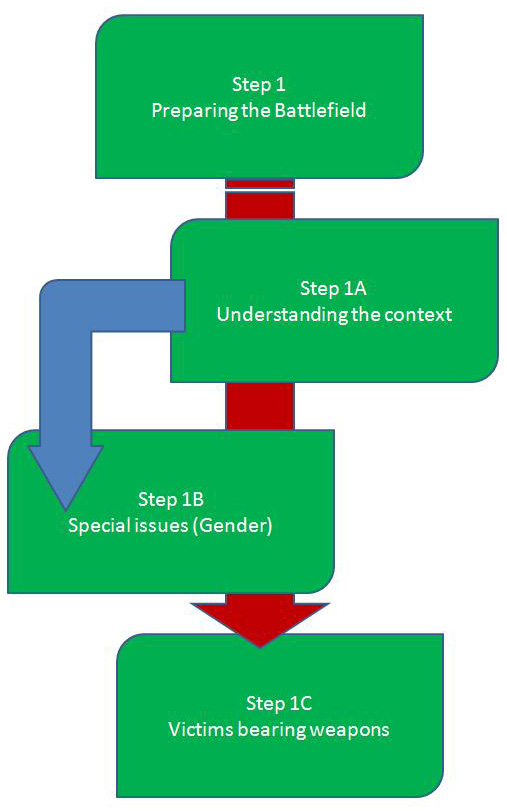
Diagram 3 - The step 1
Preparing the engagement - Preparing an engagement is a common activity involving the entire chain of command. As early as possible, a peacekeeping force must direct its headquarters staff to collect intelligence on the situation of the child soldiers, which will be use to prepare operational tools to deal with the situation, and as evidence to bring the recruiters before a court of law. The human intelligence plays a significant role in the collection and information analysis through the production of operational tools. These joint endeavors are to be brought together in a coordinated matter Information Operations (INFOPS), Psychological Operations (PSYOPS), Media and Civil-Military Cooperation (CIMIC) with two main objectives: to reduce the likelihood of direct armed confrontation with armed child soldiers and to support their return to local communities. Furthermore, the master message should be that “everything possible is done to avoid and limit child soldiers from becoming casualties, but that lethal force may be the only option; that juvenile detainees and escapees are being treated in accordance with international law and great care; that the guilt and blame lies with the people who recruit children as soldiers”15. At the same time mission legal reference documents are to be studied and clarified in order to establish confidence among the military deployed. The following simple and easy rules adopted by the large majority of the regular armies (TTP16 or Soldier’s Card style), written in the native language of those peacekeepers are a must. Proportional responses are also available to deal with different levels of threat:
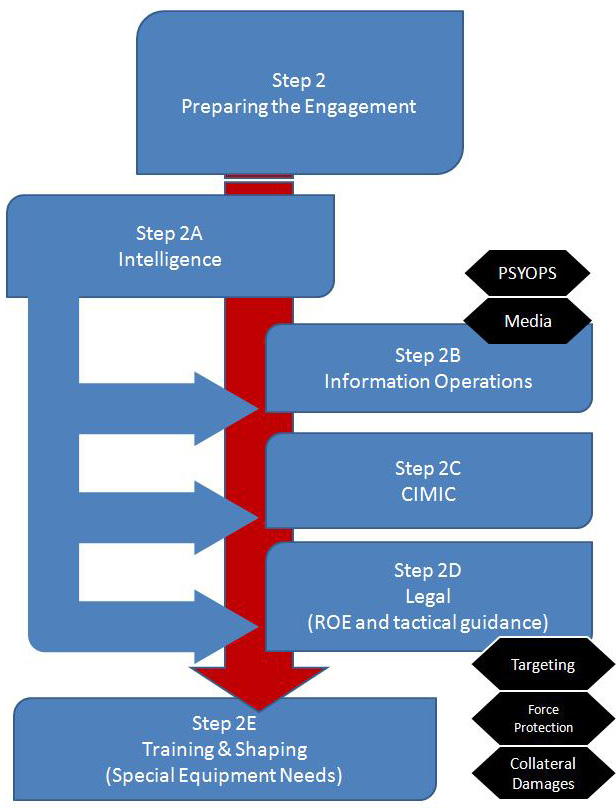
Diagram 4 - The step 2
- Warnings;
- Detention and interrogation;
- Self-defense procedures;
- Use of non-lethal force;
- Use of lethal force.
Finally, live rehearsal training situations should provide each individual the procedures and the confidence to act correctly. New equipment needs might be identified, namely those related to the application of non-lethal force.
Targeting & self-defense - Targeting and self-defense require an extensive application of the International Humanitarian Law principles. Consequently, the discrimination principle, in addition to its regular legal application, should also be used to discriminate inside the military target, between regular soldiers and child soldiers, or at least to avoid/reduce collateral damages on child soldiers. The minimum use of force and the proportionality principle are to be used together and combined with non-lethal options in case of direct engagement. The diagram 5 illustrates several options depending upon positive child solder identification and non-positive child soldier identification. In the first case (child soldier positive identification) option 1 and 2 are designed to stop a current armed threat, a hostile act or a hostile intent, without the use of deadly force. In the second (non-positive identification of a child solder but having information or having witnessed that they are engaged on the current use of armed force), option 1 and 2 are typical engagement options in self-defense.
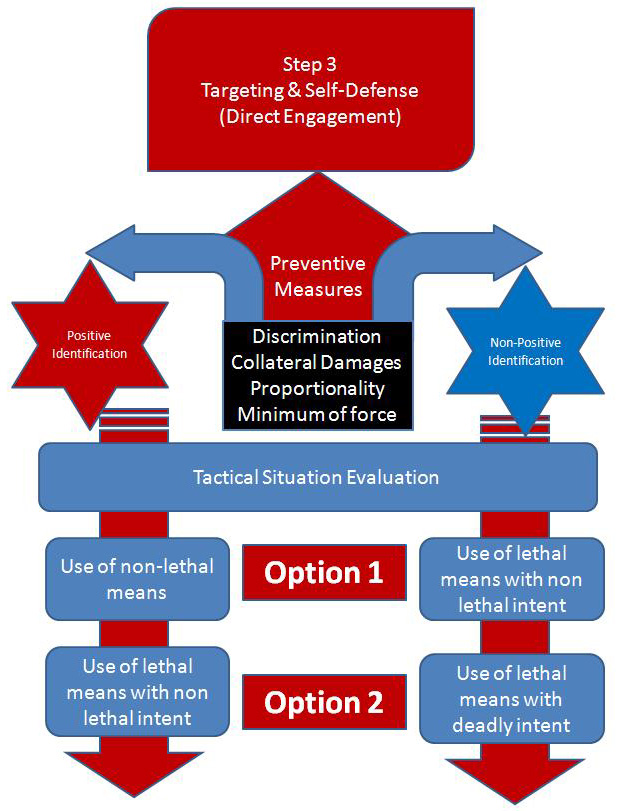
Diagram 5 - The step 3
Supporting the recruitment chain breaking - An essential aspect of dealing with child soldiering is indeed breaking the recruitment chain. We understand that this is not a typical military function in terms of peacekeeping units. Nevertheless, after being detained by peacekeepers, a child soldier needs immediate medical and psychological care. Being well looked after represents the first opportunity to act together with specialized agents and to involve directly other specialized actors. The first step to breaking this chain is to provide a minimum of psychological comfort to these minors. After that, military should assist their disarmament, and reintegration, working side by side with technical teams on the ground. Strictly, in what concern child soldering it is difficult to speak about their demobilization, once we do not consider them regular combatants. Education, society, gender, labor are among the issues to be dealt with in close coordination with the other United Nations agents, in a medium/long-term process, which aims to provide former combatants with sustainable livelihoods. At the same time, the security sector reform procedures will help to put in place a conflict exit strategy to restore the effective functioning of the State institutions.
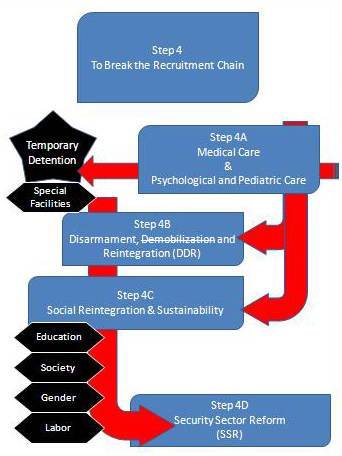
Diagram 6 - The step 4
3. Girls associated with armed forces or armed groups (GAAFG)
… Girls are recruited, or abducted as extensively as boys…
Some girls have joined armed groups by choice17.
It is probably more dangerous to be a woman than a soldier in armed conflicts mentioned Dutch Major General Patrick Cammeant, in 2008 addressing the UNSC18 Thus, it is even more dangerous to be a nice young good looking girl. The UNSCR 1820 (2008) Women and Peace and Security (§3) demands that all parties to armed conflict immediately take appropriate measures to protect civilians, including women and girls, from all forms of sexual violence, which could include, inter alia, enforcing appropriate military disciplinary measures and upholding the principle of command responsibility, training troops on the categorical prohibition of all forms of sexual violence against civilians, debunking myths that fuel sexual violence, vetting armed and security forces to take into account past actions of rape and other forms of sexual violence, and evacuation of women and children under imminent threat of sexual violence to safety. Thus, peacekeeping forces are also called to enforce these measures.
Te common and well accepted definition of child soldiers also includes girls recruited for sexual proposes and forced marriage - the so called “bush wives”. This phenomenon is placing a completely different problem when compared to the use of rape as a weapon of war by the same armed groups. The latter emphasizes the extensive abuse of women not belonging to the armed group with a humiliating intent in order to destroy the moral of the enemy and to stop the regular pace of the reproduction process by harming the heart of factory of life: the families. The immediate impact might be the psychological trauma and in the long term affects the reduction of labor force in dysfunctional communities. The goal is clearly to cause indiscriminate loses and moral breakdown in the enemy ground.
The former refers to process (forced or not) to bring girls into armed groups with the purpose of using them to the “benefit” of the members of the armed group and the performance of the armed group as such. The purpose is to gain a situational advantage (mainly tactical) by enforcing the combatants’ skills, to increase the numbers of bodies in arms, and to contribute to the “sexual satisfaction” of the regular soldiers. Therefore, both crimes have a tremendous impact on non combatant population, and in both cases heavily harm the burden of building sustainable peace.
Dealing with children associated with armed groups requires a large extend approach, with particular attention to the role of military gender advisers, working closely with other international and national actors. However, girls or young female juveniles associated with armed groups, especially in the African context, are probably one of the most demanding gender situations, once peacekeepers commanders are legally bound to protect all minors in peril. In this context, it is important to understand why girls are associated with armed groups?
- Voluntary grounds:
• To seek power (status) in a male dominated environment;
• For revenge after being abused;
• To escape from domestic violence or sexual gender based violence (SGBV);
• To seek physical protection - better to have a “husband” soldier than to be abused by many - changing protection by sex and food, in a relationship closer to the one known as “transitional sex”;
• For ideological reasons;
• To gain access to fashionable items19
• To gain access to a group;
• Due to lack of alternatives after being rejected by their communities;
• Offered by the small communities as a “tax” of war.
- Non voluntary grounds (forced enlistment):
• To stand as a model of permanent need to exercise the best skills;
• To train other girls and young kids;
• To become a “wife” (to provide food and sex to a senior soldier);
• As a weapon of war depriving a child to be educated by a ethnic group;
• To perform logistics and intelligence;
• To wage acts of war between armed groups or State regular forces;
• To wage in the used of weapons against international forces;
• To wage acts of war to save the strength of senior soldiers.
In both situations their rights are violated and in both situations there is a physical and psychological harm. In fact, girls associated with armed groups require additional layers of protection: as a minor, as a minor associated with armed groups and as female individual. To look after girls associated with armed groups requires much more than an individual will, legitimacy or material items. It is vital to be equipped with military, legal, human, technical, team attitude, and moral skills to cope with that titanic task.
4. Military peacekeeping gender advisers
Gender skills are not soft skill and should not perceived as such.
Bearing in mind the Cape Town principles and the best practices on the prevention of recruitment of children into armed forces and on demobilization and social integration in Africa (Cape Town principles, 1997), military peacekeepers need gender advisers. The UNSCR 1888 (2009) went even further establishing on paragraph 12 the following: “Decides to include specific provisions, as appropriate, for the protection of women and children from rape and other sexual violence in the mandates of United Nations peacekeeping operations, including, on a case-by-case basis, the identification of women’s protection advisers (WPAs) among gender advisers and human rights protection units, and requests the Secretary-General to ensure that the need for, and the number and roles of WPAs are systematically assessed during the preparation of each United Nations peacekeeping operation… “.
Due to the extremely difficult role of a gender adviser, working gender issues coming from the harsh external environment and inside his/her one unit might be useful to refer to their main activities. In fact they are to work within their military structure, closely to the humanitarian and legal actors, the civil society, the development actors, carrying out the following main activities:
a) To support the force build up gender sensitivity;
b) To include gender in the military planning instruments;
c) To train key leaders in gender issues;
d) To ensure that the soldiers’ card are gender sensitive;
e) To ensure that reports are gender sensitive;
f) To ensure that the flow of information is gender sensitive;
g) To ensure regular units legal and military training on handle situations involving children;
h) To contribute to promote a gender sensitive public information;
i) To participate on the ROE design and the implementation process;
j) To seek immediate release bearing in mind the best interest of the children, in particular of the girls, and to bring them to the appropriate reintegration program;
k) To prevent further recruitment actions by direct and indirect action on field commanders, by supporting the enhancement of formal State accountability mechanisms and all available informal/oversight mechanisms, namely the media; working closely with civilian actors to minimize the ultimate causes of the recruitment, and involving the educational system and community level;
l) To advice on alternatives to judicial proceeding in case of violations of the LOAC by children (with particular regard to International Covenant on Civil and Political Rights (1967), the United Nations Standard Minimum Rules for Administration of Justice for Juvenile Delinquency - the Beijing Rules - and the United Nations Guidelines for Prevention of Juvenile Delinquency - the Rijadh Guidelines - UN Doc A/45/49 1990;
m) To contribute to the protection of women and girls from public exposition, namely from an harming media coverage which is particularly unconstructive in the case of girls;
n) To support the fight against the “girls invisibility”, after being released from armed groups dominance;
o) To work closely with interpreters to prepare them to act in the context of violence against children;
p) To exchange information with the key military, non military partners, and other children protection bodies20
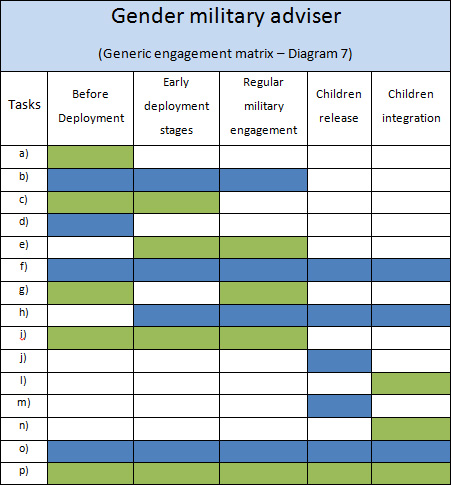
The diagram 7 represents a matrix attempting to summarize the direct involvement of gender advisers in child soldering related issues. Gender issues tend to be perceived as soft security issues and left aside by less informed commander. They tend to be left to the gender adviser to be dealt with. Gender issues should be taken as regular operational problems and dealt with by all staff, supported by the gender adviser. The low level staff also bears a tendency to look at gender as another complex “policy issue”. Thus, a role of a gender adviser demands a high level of conflict sensitivity and context awareness; it requires a long term approach in the field of trauma and impacts on the following generation; it involves vision to approach the baby steps help to reduce unforeseen side order effects; it demands a deep understanding that girls associated with armed groups phenomenon is a symptom and not the cause of the problem; it fosters all to understand that accountability measures should not be dependent of the good will, and finally he or she are to set his/her mind in order to understand that the value of an action is measured by the effects produced and not by the amount of money allocated. A gender adviser is an extremely important role not well perceived by few and hopefully strongly supported by many.
7. The horrible option is never the solution
Child soldiers tend to protract armed violence.
Nowadays, peacemaking intends to deliver more than ending the war; it lays the normative ground for transition and sets the agenda for a long standing peacetime21 Child soldiering tends to protract armed violence, since after the termination of the conflict former child soldiers hold the only power recognized by them: the power of weapons. It is indeed hard to change that for a project of a better live in the long run. However, that fact does not support treating child soldiers as regular combatants because it raises the scale of predatory brutality to the absurd and increases the threat to regional stability in the post-conflict to unacceptable levels. Furthermore, “using violent means against children by armies from developed, industrial countries contravenes not only codes of human conduct against enemies, but touches upon some basic understandings about us as human beings”22 As a result, the horrible option (as General Roméo Dallaire named it23 to fight back employing lethal fire even in self-defense without considering other options, is never a solution. In fact, it creates many legal problems, it might generate individual criminal accountability, it poses new ethical problems, and it turns the transitional process towards peace longer and harder. Children soldiers showing a threatening posture towards peacekeeping forces are a legitimate target to detain, to keep in custody24 to disarm, to neutralize, to separate from adult dominance, and as a last resort to use lethal fire with non lethal intent. The centre of gravity to disrupt the use of children in armed conflicts is the leadership of senior juveniles or adult leaders who exercise complete power over those innocent victims, together with those who effectively control the recruitment activities. We are to help our military to replace - since the very beginning of their basic training - the idea of “child soldering” for the new concept of “children associated with armed groups or armed forces”. Child soldering places children in the other side and direct links them to an armed answer. Instead, children associated with armed groups leverage the idea of being victims, and recalls immediate protection. In this way it will be easy to make them to understand the complex nature of a child bearing arms or working for the military. As mentioned by David Crane25 justice is to be served against those who mistreat children by committing against them a brutal crime of stealing their childhood. Military commanders of peacekeeping forces play a fundamental role dealing with children associated with armed groups, especially through their leadership, disciple and their will to enforce accountability and support integration. Individual peacekeepers must understand that they are there to protect youth, not to destroy it in self-defense. That would, indeed, amount to the grossest human indecency.
* Tenente-coronel de Artilharia. Doutorado em Ciência Política e Relações Internacionais, com especialização em Direito Internacional Humanitário. Presta serviço na EUROFOR.
1 Cape Town Principles and best practices (1997) - 'Child soldier' in this document is any person under 18 years of age who is part of any kind of regular or irregular armed force or armed group in any capacity, including but not limited to cooks, porters, messengers and anyone accompanying such groups, other than family members. The definition includes girls recruited for sexual purposes and for forced marriage. It does not, therefore, only refer to a child who is carrying or has carried arms - Source: http://www.unicef.org/emerg/files/Cape_Town_Principles(1).pdf.
2 Rules of Engagement (ROE).
3 Coltan is the industrial name for columbite-tantalit, which is a dull black metallic mineral use to manufacture electronics such as cell phones, DVD players, video games and computers.
4 UNITAR/GCDCAF - Security Sector Reform Foundation Course, Lesson 2, 2011, (gender issues) pg. 8.
5 For reference might be useful to see the Statement by the President of the Security Council, 17th of July 2008.
6 Security Council Resolution 1612 (2005) on Children and Armed Conflicts, §1.
7 Article 1º of the Convention on the Rights of the Child specifies that, for the purposes of that Convention, a child means every human being below the age of 18 years unless, under the law applicable to the child, majority is attained earlier. International Crime Court Statute articles 8 2. b) xxvi and 8 2. e) vii - Conscripting or enlisting children under the age of fifteen years...
8 Optional Protocol to the Convention on the Rights of the Child on the involvement of children in armed conflict, adopted and opened for signature, ratification and accession by General Assembly Resolution A/RES/54/263 of 25th of May 2000 and entered into force on 12th of February 2002 - Source: http://www2.ohchr.org/english/law/crc-conflict.htm.
9 It is largely accepted that the use of child soldiers in armed conflicts amounts to a violation of their rights and should be consider a war crime (OUA Council of Ministers, Resolution 1659 (1996), ICC Statute, SCSL Statute, and national legislation without known official practice). But besides that, is necessary to consider that in case of direct participation in armed conflicts, children continue to benefit from a special protection to which they are entitled, whether they are prisoners of war or not (Additional Protocol I, article 77 3), adopted by consensus).
10 Draft Statute of ICC quoted by Jean-Marie Henckaerts and Louise Doswald-Beck in Customary International Humanitary Law, ICRC, 2009, pg. 478.
11 Harvard Human Rights Journal - The Protection of Children in Peacemaking and Peacekeeping Processes, pg. 148. Source: http://www.law.harvard.edu/students/orgs/hrj/iss12/cohn.shtml.
12 The Council has condemned the use and recruitment of child soldiers in several Security Council Resolutions, namely 1261 (1999), 1308 (2000), 1314 (2000), 1325 (2000), 1379 (2001), 1460 (2003), 1539 (2004), and 1612 (2005) Children and armed conflict 1. Strongly condemns the recruitment and use of child soldiers by parties to armed conflict in violation of international obligations applicable to them and all other violations and abuses committed against children in situations of armed conflict...
13 Chapter 1, The Normative Framework for United Nations Peacekeeping Operations, pg. 16 - Source: http://pbpu.unlb.org/pbps/Library/Capstone_Doctrine_ENG.pdf.
14 RTO-TM-HFM-159, pg 6-1.
15 RTO-TM-HFM-159, pg 6-3.
16 Tactical, Techniques and Procedures.
17 Beth Verhey Reaching the Girls, Study on Girls Associated with Armed Forces and Groups in the Democratic Republic of Congo, Save the Children UK and the NGO Group: CARE, IFESH and IRC, November 2004, pg. 6 and 10.
18 European Security Defence College, Comprehensive Gender Approach to Operations Course, December 2011.
19 As mentioned by the famous red shoes stories - Mrs Irma Specht, Transition International addressing at Comprehensive Approach to Gender in Operation Course organized by the European Security and Defense College in Delft (The Netherlands) (November, 2011).
20 1925 (2010) - Recalling its resolutions 1325 (2000) and 1888 (2009) on women and peace and security, its resolution 1894 (2009) on the protection of civilians in armed conflicts, and its resolution 1882 (2009) on children and armed conflict, and recalling the conclusions of the Security Council Working Group on Children and Armed Conflict pertaining to parties in the armed conflict of the Democratic Republic of the Congo… 12 f) Implement the United Nations system-wide protection strategy in the Democratic Republic of the Congo, operationalizing it with MONUSCO’s protection strategy built on best practices and extend useful protection measures, such as the Joint Protection Teams, Community Liaison Interpreters, Joint Investigation Teams, Surveillance Centers and Women’s Protection Advisers…
21 Harvard Human Rights Journal - The Protection of Children in Peacemaking and Peacekeeping Processes, pg. 131. Source: http://www.law.harvard.edu/students/orgs/hrj/iss12/cohn.shtml.
22 RTO-TM-HFM-159, pg 6-1.
23 General Roméo Dallaire, “They fight like soldiers, they die like children”, 2010, pg 225.
24 The European Convention on Human Rights imposes European Union States the duty not to transfer detainees, unless there is a guarantee that their fundamental rights will be respected. This provision is reaffirmed by the article 37 of the Convention on the Rights of Children (1989). Source: http://www2.ohchr.org/english/law/crc.htm#art37.
25 General Roméo Dallaire, “They fight like soldiers, they die like children”, 2010, pg 180.










